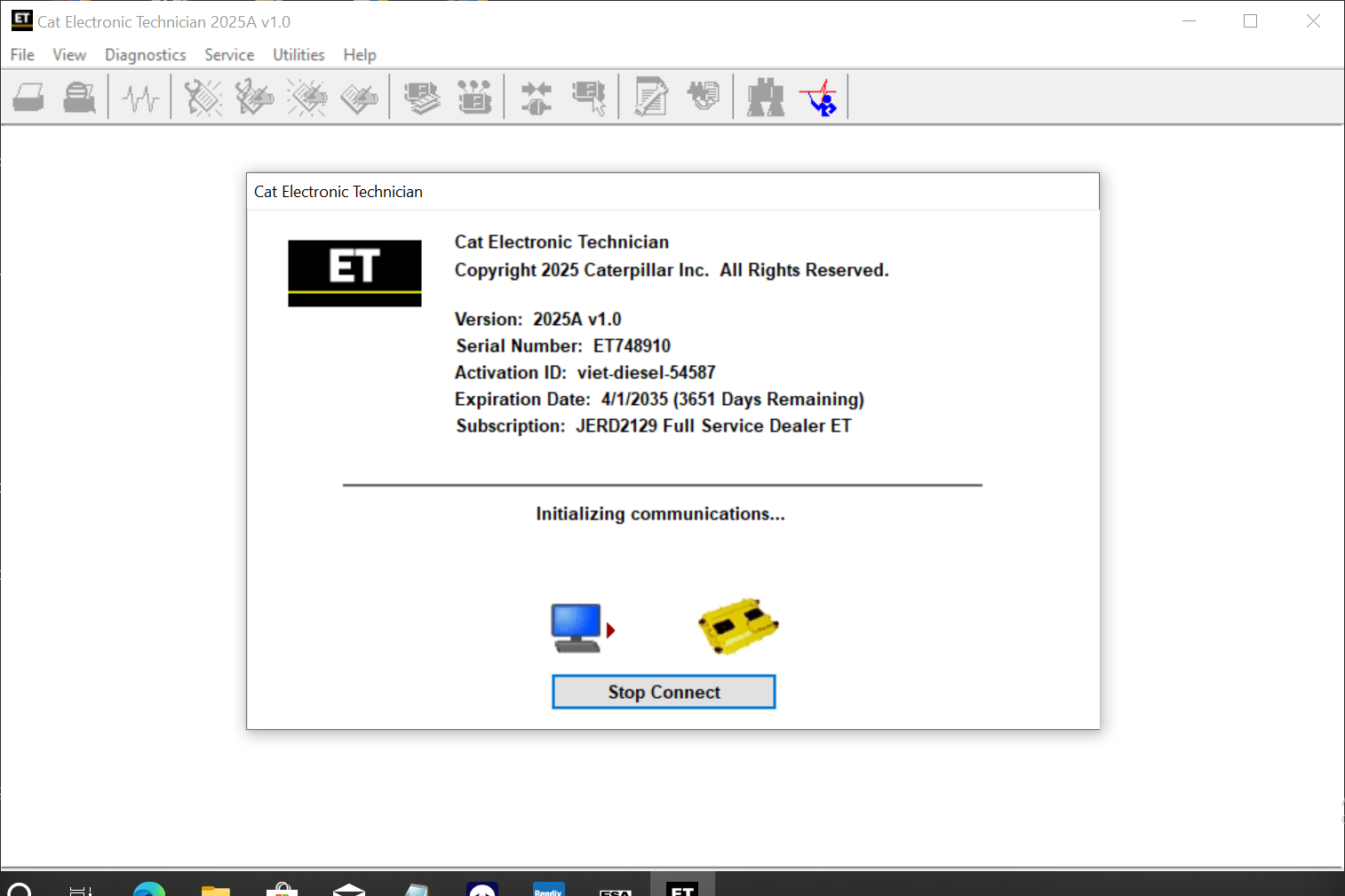CAT ELECTRONIC TECHNICIAN
126 $ Original price was: 126 $.105 $Current price is: 105 $.
Brand: CAT ELECTRONIC TECHNICIAN
Version: 2025A
File Size: Approximately 578 MB
License Time: 2 year
Software Type: Diagnostic and service tool
Region: Global
OS Support: Windows 10 and 11
Category: All Product
Size Installed: Approximately 1.5 GB
Database Language: English
Interface Language: English
The role of a CAT ELECTRONIC TECHNICIAN is integral to the smooth operation and maintenance of heavy machinery, specifically in industries where Caterpillar equipment is prevalent. This blog post delves deeply into various aspects of this profession, aiming to illuminate the skills, opportunities, and advancements that define the field of CAT Electronic Technicians.
Introduction to CAT Electronic Technician
In an age where technology shapes our world, the job of a CAT Electronic Technician stands out as both challenging and rewarding. These technicians specialize in diagnosing, repairing, and maintaining electronic systems in Caterpillar machinery, which are extensively used in construction, mining, and agriculture. The complexity of modern machinery has evolved dramatically, necessitating skilled technicians who can navigate intricate electronic systems.
Caterpillar, renowned for its innovation, produces machinery equipped with advanced electronics and diagnostics. As a result, the demand for proficient CAT Electronic Technicians has surged. In this introduction, we will explore the foundational aspects of this career, highlighting its importance and relevance in today’s technologically driven environment.
The Growing Importance of Electronics in Heavy Machinery
As industries continue to modernize, the reliance on sophisticated electronic systems within heavy machinery increases. Whether it’s through improved fuel efficiency or enhanced safety features, electronics play a vital role in ensuring that equipment operates efficiently.
For CAT Electronic Technicians, this means staying ahead of the curve when it comes to understanding and adapting to new technologies. Their expertise not only helps prevent costly downtime but also contributes to the overall productivity and safety of operations.
Overview of the Role
A CAT Electronic Technician is responsible for troubleshooting, repairing, and maintaining electronic systems in Caterpillar machinery. This includes power generation systems, hydraulic controls, engine management systems, and more. The technician must interpret diagnostic codes, utilize specialized software, and understand wiring schematics to perform their duties effectively.
By combining technical proficiency with problem-solving skills, CAT Electronic Technicians ensure that machinery remains operational, adhering to industry standards and regulations.
Key Skills Required for CAT Electronic Technicians
To excel as a CAT Electronic Technician, several key skills are essential. These skills range from technical knowledge to soft skills that enable effective communication and teamwork.
Technical Proficiency in Electronics
At the core of a CAT Electronic Technician’s skill set is a deep understanding of electronics and electrical systems. Knowledge of circuits, sensors, actuators, and controllers is crucial.
Technicians must be adept at using diagnostic tools and software to identify issues within complex electronic systems. This proficiency allows them to troubleshoot problems effectively and implement timely repairs, minimizing downtime and ensuring optimal performance.
Problem-Solving Abilities
Problem-solving is a fundamental skill for any technician, particularly in the unpredictable environments where heavy machinery operates. A CAT Electronic Technician must approach challenges methodically, analyzing symptoms, testing hypotheses, and implementing solutions.
Additionally, creativity plays a role in problem-solving. Technicians often encounter unique issues that require innovative thinking to resolve. This ability to think outside the box can significantly enhance a technician’s effectiveness and reputation within the industry.
Communication and Teamwork Skills
While technical skills are paramount, interpersonal skills also hold significant value in this profession. CAT Electronic Technicians often work as part of a larger team, collaborating with engineers, operators, and other technicians. Effective communication fosters a collaborative environment, ensuring that everyone understands the status of repairs and maintenance tasks.
Moreover, strong customer service skills are vital when interacting with clients. Technicians should be able to explain technical issues clearly and provide recommendations to non-technical stakeholders, fostering trust and satisfaction.
Career Opportunities for CAT Electronic Technicians
The landscape for CAT Electronic Technicians is rich with opportunities. As industries increasingly rely on advanced machinery, the demand for skilled technicians continues to rise.
Diverse Industries
CAT Electronic Technicians can find employment across a variety of sectors, including construction, mining, agriculture, and transportation. Each of these fields relies heavily on Caterpillar machinery, creating a steady need for qualified technicians.
Working in different industries offers technicians the chance to diversify their skills and adapt to varying workplace cultures and demands. This diversity not only enhances their employability but also enriches their professional experience.
Advancement Opportunities
Career advancement is attainable for CAT Electronic Technicians who demonstrate exceptional skills and commitment. With experience, technicians may move into supervisory roles or transition into specialized areas such as quality control or training.
Technicians may also choose to pursue additional certifications or education, paving the way for higher-level positions within their organization. Such advancements can lead to increased responsibilities, higher salaries, and greater job satisfaction.
Entrepreneurial Ventures
For those with an entrepreneurial spirit, there is also the potential to start independent businesses focusing on repair and maintenance services for Caterpillar machinery. This path allows technicians to leverage their expertise while providing valuable services to local industries.
Running a business comes with its own set of challenges, but for passionate technicians, this can be a fulfilling avenue that combines technical skills with entrepreneurship.
Educational Pathways for CAT Electronic Technicians
Education is a fundamental aspect of becoming a CAT Electronic Technician. Various pathways can lead individuals to this career, each offering unique advantages.
Formal Education Programs
Many technicians begin their journey by enrolling in formal education programs focused on electronics or automotive technology. Community colleges and technical schools often offer programs specifically tailored to heavy equipment repair and maintenance.
These programs typically cover essential subjects such as electrical theory, circuit analysis, and diagnostic processes. Hands-on training provides students with practical experience, equipping them with the skills needed to succeed in the field.
On-the-Job Training and Apprenticeships
In addition to formal education, on-the-job training plays a pivotal role in shaping a technician’s skill set. Many employers offer apprenticeship programs that allow aspiring technicians to learn alongside experienced professionals.
This type of training provides invaluable insights into real-world challenges and reinforces the theoretical knowledge gained during formal education. It also allows technicians to build relationships within the industry, which can be beneficial for future career opportunities.
Continuing Education and Professional Development
Given the rapid advancements in technology, ongoing education is crucial for CAT Electronic Technicians. Participating in workshops, seminars, and certification programs can help technicians stay current with the latest developments in machinery and electronics.
Many organizations, including manufacturers and trade associations, offer resources and training opportunities designed to support continuous learning. By investing in their professional development, technicians can enhance their skill set and remain competitive in the job market.
Tools and Equipment Used by CAT Electronic Technicians
Tools and equipment are central to the daily tasks performed by CAT Electronic Technicians. Familiarity with the right tools not only facilitates efficient repairs but also ensures that work is completed safely and accurately.
Diagnostic Tools and Software
One of the most critical sets of tools used by CAT Electronic Technicians are diagnostic tools and software. These tools enable technicians to communicate with machinery’s onboard computers, allowing them to retrieve diagnostic codes and assess system performance.
The use of specialized diagnostic equipment enhances the efficiency of troubleshooting processes, leading to quicker resolutions of complex issues. Additionally, software applications can provide insights into machine history, helping technicians make informed decisions about repairs and maintenance.
Hand Tools and Equipment
In addition to diagnostic tools, CAT Electronic Technicians rely on various hand tools to perform repairs. Commonly used items include multimeters, oscilloscopes, wrenches, screwdrivers, and soldering equipment.
Having a comprehensive toolkit not only aids in day-to-day tasks but also empowers technicians to tackle unexpected challenges as they arise. Proper maintenance and organization of tools are equally important, ensuring that technicians can access what they need quickly when faced with urgent repairs.
Safety Equipment
Safety is paramount in the field of heavy machinery. CAT Electronic Technicians must adhere to strict safety protocols and utilize appropriate personal protective equipment (PPE). This may include safety glasses, gloves, hard hats, and high-visibility clothing.
Understanding safety measures is essential not only for personal protection but also for the well-being of colleagues and operators working in proximity to repairs. A strong safety culture promotes a positive work environment and reduces the risk of accidents.
Common Challenges Faced by CAT Electronic Technicians
While the role of a CAT Electronic Technician is rewarding, it is not without challenges. Understanding these hurdles can better prepare aspiring technicians for the realities of the job.
Complexity of Modern Machinery
Modern Caterpillar machines are equipped with increasingly sophisticated electronic systems. While this innovation enhances efficiency, it also complicates diagnostics and repairs.
Technicians must continually update their knowledge to keep pace with technological advancements. This ongoing education can be time-consuming and demanding, as technicians strive to maintain their technical proficiency amidst ever-evolving machinery.
Working Conditions
CAT Electronic Technicians often work in demanding conditions, ranging from extreme weather to confined spaces. Such environments can pose physical challenges and require technicians to adapt their approaches to ensure safety and efficiency.
Managing these conditions is crucial for successful repairs. Technicians must possess resilience and ingenuity to navigate various obstacles, whether dealing with inclement weather or limited access to machinery.
Time Constraints and Pressure
In industries reliant on heavy machinery, downtime can lead to significant losses. Consequently, CAT Electronic Technicians frequently face pressure to complete repairs swiftly without compromising quality.
Balancing speed and accuracy requires excellent time management skills and the ability to prioritize tasks effectively. Over time, technicians develop strategies to work efficiently while maintaining high standards of workmanship.
Advancements in Technology for CAT Electronic Technicians
The field of electronics in heavy machinery is rapidly evolving, presenting exciting opportunities for CAT Electronic Technicians. Staying informed about technological advancements is crucial for success in this profession.
Integration of Automation
Automation is transforming the landscape of heavy machinery. Machines equipped with autonomous features can operate with minimal human intervention, enhancing efficiency and safety.
For CAT Electronic Technicians, this shift means developing new competencies focused on automated systems and remote diagnostics. Embracing automation can lead to improved job prospects and the ability to work on cutting-edge machinery.
Data-Driven Decision Making
The rise of data analytics is another significant trend impacting CAT Electronic Technicians. Machine learning algorithms analyze performance data, providing technicians with insights to optimize operations and predict maintenance needs.
By leveraging data-driven decision-making, technicians can enhance their troubleshooting processes and improve preventive maintenance strategies. This proactive approach can extend machinery lifespan and reduce operational costs for businesses.
Enhanced Training Tools
Advancements in technology have also led to the development of sophisticated training tools. Virtual reality (VR) and augmented reality (AR) simulations allow technicians to practice their skills in lifelike scenarios without the risks associated with hands-on training.
These immersive training experiences can significantly enhance learning outcomes and prepare technicians for real-world challenges. As technology continues to evolve, embracing these tools will be essential for staying ahead in the industry.
Certification Programs for CAT Electronic Technicians
Obtaining relevant certifications can significantly enhance a CAT Electronic Technician’s qualifications and career prospects. Various programs exist that focus on specific skills and competencies within the field.
Industry-Recognized Certifications
Several industry-recognized certifications validate a technician’s expertise in specific areas of electronics and heavy machinery. Organizations such as the National Institute for Certification in Engineering Technologies (NICET) and the Equipment & Engine Training Council (EETC) offer programs tailored to heavy equipment technicians.
These certifications can enhance a technician’s resume and demonstrate their commitment to professional development. Furthermore, obtaining certification often leads to higher earning potential and increased job opportunities.
Manufacturer-Specific Training Programs
Caterpillar and other machinery manufacturers often provide specialized training and certification programs for technicians. These programs focus on the specific technologies and systems utilized in their equipment, equipping technicians with in-depth knowledge of their products.
Participating in manufacturer-specific training not only builds expertise but also establishes a strong connection with the brand. Technicians can become trusted resources for clients and employers, fostering long-term professional relationships.
Ongoing Education Requirements
Many certifications require continual education to maintain their validity. Technicians must stay up-to-date with advancements in technology and industry best practices. This commitment to lifelong learning is crucial in a field characterized by rapid change.
Embracing ongoing education demonstrates a technician’s dedication to excellence, fostering trust among employers and clients alike.
Job Responsibilities of a CAT Electronic Technician
The day-to-day responsibilities of a CAT Electronic Technician encompass a wide range of tasks, all aimed at ensuring the functionality and reliability of heavy machinery.
Diagnostics and Troubleshooting
One of the primary responsibilities of CAT Electronic Technicians is conducting thorough diagnostics on machinery. Technicians utilize advanced diagnostic tools to analyze electronic systems, identify faults, and recommend necessary repairs.
This process involves interpreting error codes, checking wiring connections, and assessing component functions. Effective diagnostics pave the way for targeted repairs, ensuring minimal disruption to operations.
Repairs and Maintenance
Once issues have been diagnosed, technicians proceed to perform repairs and maintenance on electronic systems. This may involve replacing faulty components, recalibrating sensors, or updating software.
Attention to detail is critical during this phase, as even minor errors can lead to significant operational challenges. Technicians must adhere to manufacturer specifications and industry standards to ensure quality workmanship.
Documentation and Reporting
Documentation is an essential aspect of a CAT Electronic Technician’s role. Technicians are responsible for recording maintenance activities, repairs performed, and any parts replaced.
Accurate documentation ensures compliance with safety regulations and provides valuable insights for future maintenance needs. Technicians may also prepare reports for management, summarizing findings and recommendations based on their assessments.
Future Trends in CAT Electronic Technology
As the landscape of electronics in heavy machinery evolves, numerous trends are emerging that will shape the future of CAT Electronic Technicians.
Increased Focus on Sustainability
Sustainability is a growing concern in many industries, and the heavy machinery sector is no exception. Future trends indicate a shift towards eco-friendly technologies, including electric and hybrid machinery.
For CAT Electronic Technicians, this shift will require adapting to new systems and understanding how to maintain and repair alternative power sources. Embracing sustainability will play a significant role in the future of the industry.
Greater Connectivity Through IoT
The Internet of Things (IoT) is revolutionizing how machinery communicates and operates. As more machines become interconnected, technicians will need to develop skills related to network connectivity and cybersecurity.
Understanding IoT systems will empower technicians to manage data streams effectively, enabling predictive maintenance and real-time monitoring of equipment performance. This evolution presents exciting opportunities for advancing technician capabilities.
Expansion of Remote Support Services
Remote support services are transforming how technicians assist clients. Utilizing advanced communication technologies, technicians can diagnose and troubleshoot issues remotely, reducing the need for onsite visits.
This development enhances efficiency and minimizes downtime for clients. For CAT Electronic Technicians, expanding skill sets to include remote support capabilities will be vital for staying competitive in the evolving job market.
Conclusion
The position of a CAT ELECTRONIC TECHNICIAN is pivotal in today’s technologically advanced industrial landscape. From mastering the complexities of electronic systems to navigating the challenges posed by modern machinery, technicians play a crucial role in maintaining operational efficiency across various sectors.
As the industry continues to evolve, the importance of continuous education, adaptation to new technologies, and a commitment to safety and quality will remain paramount. By embracing these principles, CAT Electronic Technicians can not only enhance their careers but also contribute to the overall success and sustainability of the industries they serve.
In summary, pursuing a career as a CAT Electronic Technician opens the door to a world of opportunities, challenges, and advancements that promise to shape the future of heavy machinery and electronics. Whether you’re just starting your journey or looking to advance your existing career, the realm of CAT Electronic Technicians offers a wealth of possibilities worth exploring.
📥 Contact Us:
🌐 Website: www.diagtechpro.com
📲 WhatsApp: https://wa.me/message/K6JOQMVFBGSAD1
📧 Email: di4gtechpro@gmail.com
Be the first to review “CAT ELECTRONIC TECHNICIAN” Cancel reply
Related products
All Product
All Product
All Product
Cummins CalFix for INSITE – Powerful Engine Calibration and Fault Fixing for Cummins Engines















Reviews
There are no reviews yet.